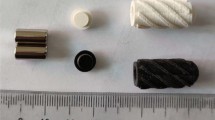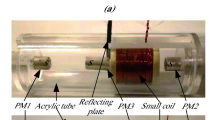Abstract
Based on the critical gap phenomenon of the intestinal capsule robot, a variable-diameter capsule robot with radial gap self-compensation is developed in this paper. With the functional variation principle, a fluid dynamic pressure model satisfying the boundary conditions of the outer surface of capsule robot with screw blades is derived. The critical gap phenomenon is studied theoretically and experimentally based on the end effect and the dynamic balance characteristics of the fluid on the surface of capsule robot. The concept of start-up rotation speed is defined, the relationship between the start-up rotation speed and the spiral parameters of capsule robot is investigated. The strategy for implementing drive and control on several capsule robots under the same rotational magnetic field is proposed, and by defining the start-up curves of several capsule robots with the similar motion regulation as the objective functions, genetic algorithm is employed to optimize the spiral parameters of several capsule robots. Experiments have shown that the proposed drive and control strategy for several capsule robots can be implemented effectively. It has a good prospect of application inside intestine to realize the drive and control on several capsule robots for different medical purposes.
Similar content being viewed by others
References
Dario P, Hannaford B, Menciassi A. Smart surgical tools and augmenting devices. IEEE Trans Rob Autom, 2003, 19: 782–791
MacFadyen B V, Cuschieri A. Endoluminal surgery. Surg Endosc, 2005, 19: 1–3
Cuschieri A, Melzer A. The impact of technologies on minimally invasive therapy. Surg Endosc, 1997,11: 91–92
Cuschieri A. Minimally invasive surgery: Hepatobiliary-pancreatic and foregut. Endosc, 2000, 32: 331–344
Schostek S, Fischer H, Kalanovic D, et al. Microsystems in medicine-Results of an international survey. Minimally Invasive Therapy Allied Technol, 2005, 14: 360–368
Swain P, Iddan G, Meron G, et al. Wireless capsule endoscopy of the small bowel: Development, testing and first human trials. Proc SPIE, 2001, 41: 19–23
Iddan G, Meron G, Glukhovsky A, et al. Wireless capsule endoscopy. Nature, 2000, 405: 417–418
Meron G. The development of the swallable video capsule (M2A). Gastrointest Endosc, 2000, 52: 817–819
RF System Lab. NORIKA3. Available (English): http://www.rfamerica.com/sayaka/; (Japanese). 2001
Olympus. [Online]. Available: (English): http://www.olympus-globle.co-m/en/news/2005b/nr051013capsle.cfm (Accessed in 2008)
Jian X Y, Mei T, Wang X H. Driving method of an endoscopic robot capsule by external magnetic field. Robot, 2005, 27: 367–372
Zhang Y, Jiang S, Zhang X, et al. Dynamic characterristics of an intestine capsule robot with variable diameter. Chin Sci Bull, 2010, 55: 1813–1821
Phee L, Accoto D, Menciassi A, et al. Analysis and development of locomotion devices for the gastrointestinal tract. IEEE Trans Biomed Eng, 2002, 49: 613–616
Phee L, Menciassi A, Gorini S, et al. An innovative locomotion principle for minirobots moving in the gastrointestinal tract. In: Proceedings of IEEE International Conference on Robotics and Automation, Washington DC: IEEE, 2002. 1125-1130
Dario P, Ciarletta P, Menciassi A, et al. Modeling and experimental validation of the locomotion of endoscopic robots in the colon. Int J Rob Res, 2004, 23: 549–556
Accoto D, Stefanini C, Phee L, et al. Measurements of the Frictional Properties of the Gastrointestinal Tract. Vienna: The World Tribology Congress, 2001
Menciassi A, Stefanini C, Gorini S, et al. Legged locomotion in the gastrointestinal tract problem analysis and preliminary technological activity. In: Proceedings of IEEE International Conference on Intelligent Robots and Systems, Sendai: IEEE, 2004. 937–942
Kassim I, Phee C L, Wan N G. Locomotion techniques for robotic colonoscopy. IEEE Eng Med Biol Maga, 2006, 25: 49–56
Wang X N, Meng M.Q-H. An inchworm-like locomotion mechanism based on magnetic actuator for active capsule endoscope. In: Proceedings of IEEE/RSJ International Conference on Intelligent Robots and Systems, Beijing: IEEE, 2006. 1267–1272
Guozheng Y, Qiuong L, Guoqing D, et al. The prototype of a piezoelectric medical robot. In: Proceedings of IEEE International Symposium on Micromechatronics and Human Science, Nagoya: IEEE, 2002. 73–77
Kim B, Lee S, Park J H, et al. Design and fabrication of a locomotive mechanism for capsule-type endoscopes using shape memory alloys (SMAs). IEEE/ASME Trans Mechatron, 2005, 10: 77–86
Menciassi A, Stefanini C, Gorini S, et al. Locomotion of a legged capsule in the gastrointestinal tract: Theoretical study and preliminary technological result. In: Proceedings of IEEE International Conference Engineering in Medicine and Biology Society, San Francisco: IEEE, 2004. 2767–2770
Dario P, Menciassi A, Stefanini C, et al. Teleoperated endoscopic capsule equipped with active locomotion system. WIPO Patent WO 2005082248, 2005-09-09
Quirini M, Menciassi A, Scapellato S, et al. Design and fabrication of a motor legged capsule for the active exploration of the gastrointestinal tract. IEEE/ASME Tracs Mechatron, 2008, 13: 169–179
Carta R, Thone J, Puers R. A wireless power supply system for robotic capsular endoscopes. Sens Actuators A, 2010, 162: 177–183
Cristofaro S, Stefanini N, Susilo E, et al. Electromagnetic wobble micromotor for microrobots axtuation. Sens Actuators A, 2010, 161: 234–244
Ikeuchi K, Yoshinaka K, Hashimoto S, et al. Locomotion of medical micro robot with spiral ribs using mucus. In: Proceedings of IEEE International Symposium on Micro Machine and Human Science, 1996. 217–222
Zhang Y, Yu H, Ruan X, et al. Kinematics characteristics of a new capsule-type micro robot in intestine. J Mech Eng, 2009, 45: 18–23
Saladin K S. Human Anatomy. Boston: McGraw-Hill Higher Education, 2005
Zhang Y, Jiang S, Zhang X, et al. A variable diameter capsule robot based on multiple wedge effects, IEEE/ASME Tracs Mechatron, 2011, 16: 241–254
Zhang Y, Wang D, Guo D, et al. Characteristics of magnetic torque of a capsule micro robot applied in intestine. IEEE Trans Magn, 2009, 45: 493–503
Zhang Y, Yue M, Guo D, et al. Characteristics of spatial magnetic torque of an intestine capsule micro robot with variable diameter. Sci China Ser E-Tech Sci, 2009, 52: 2079–2086
Baiocchi C, Capelo A. Variational and Quasivariational Inequalities Applications to Free Boundary Problems. New York: John Wiley& Sons, 1984
Qiu Z G. Analytical solution for a class of quadrilateral stepped slider bearing of micropolar fluid. Lubrication Eng, 1989, 2: 13–20
Gent A N. Engineering with rubber — how to design rubber components. USA: Hanser Gardner Publications, 2001
SZERI A. Fluid Film Lubrication: Theory and Design. Cambridge: Cambridge University Press, 1998
Pinkus O, Sternlicht B. Theory of Hydrodynamic Lubrication. New York: McGraw Hill Co., 1961
Author information
Authors and Affiliations
Corresponding author
Rights and permissions
About this article
Cite this article
Zhang, Y., Wang, D., Ruan, X. et al. Control strategy for multiple capsule robots in intestine. Sci. China Technol. Sci. 54, 3098–3108 (2011). https://doi.org/10.1007/s11431-011-4483-0
Received:
Accepted:
Published:
Issue Date:
DOI: https://doi.org/10.1007/s11431-011-4483-0




